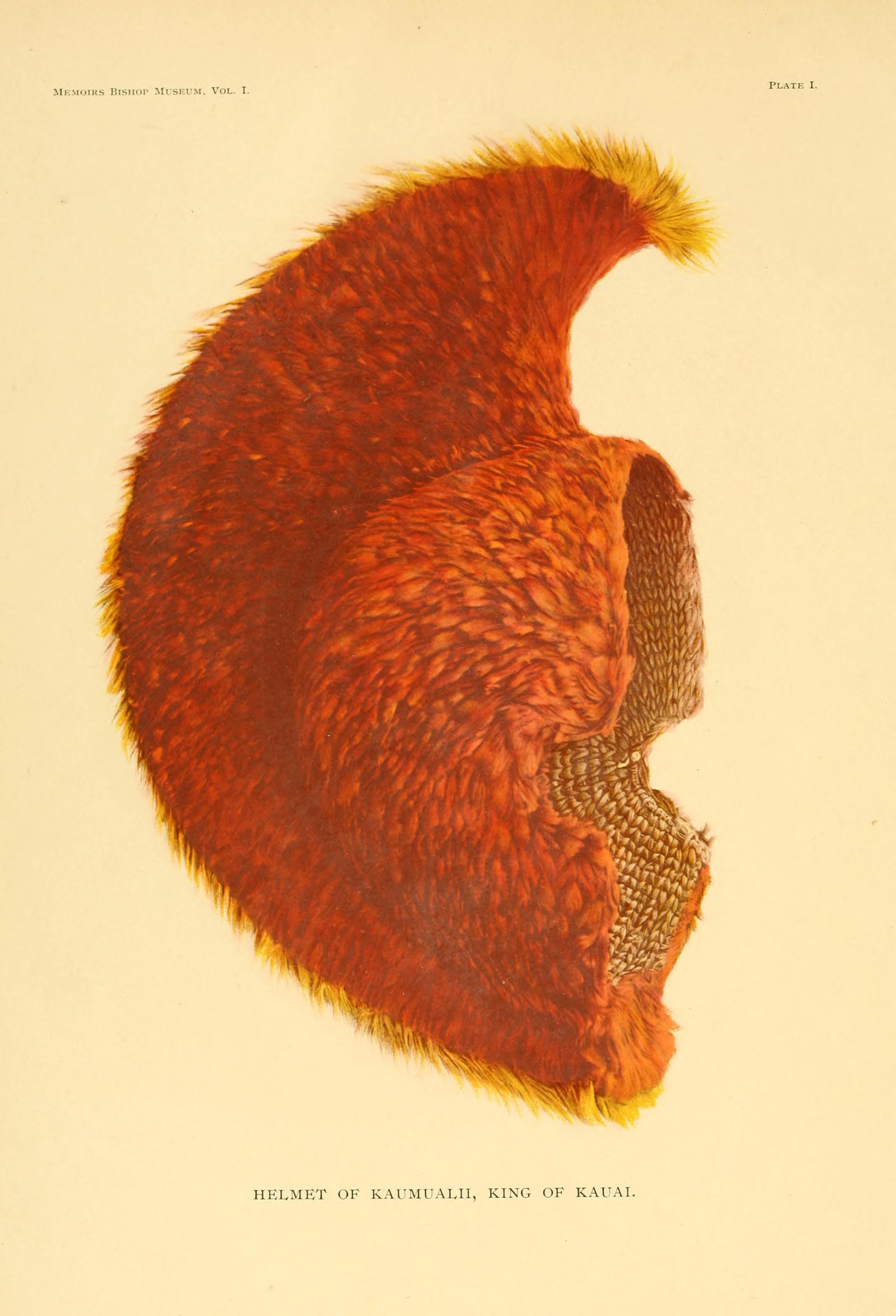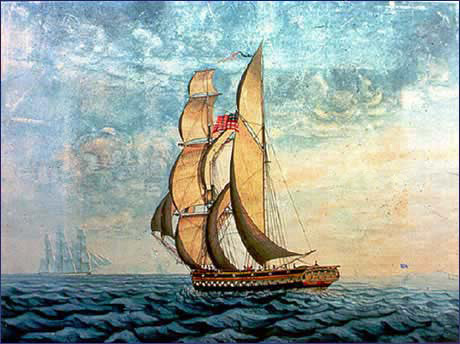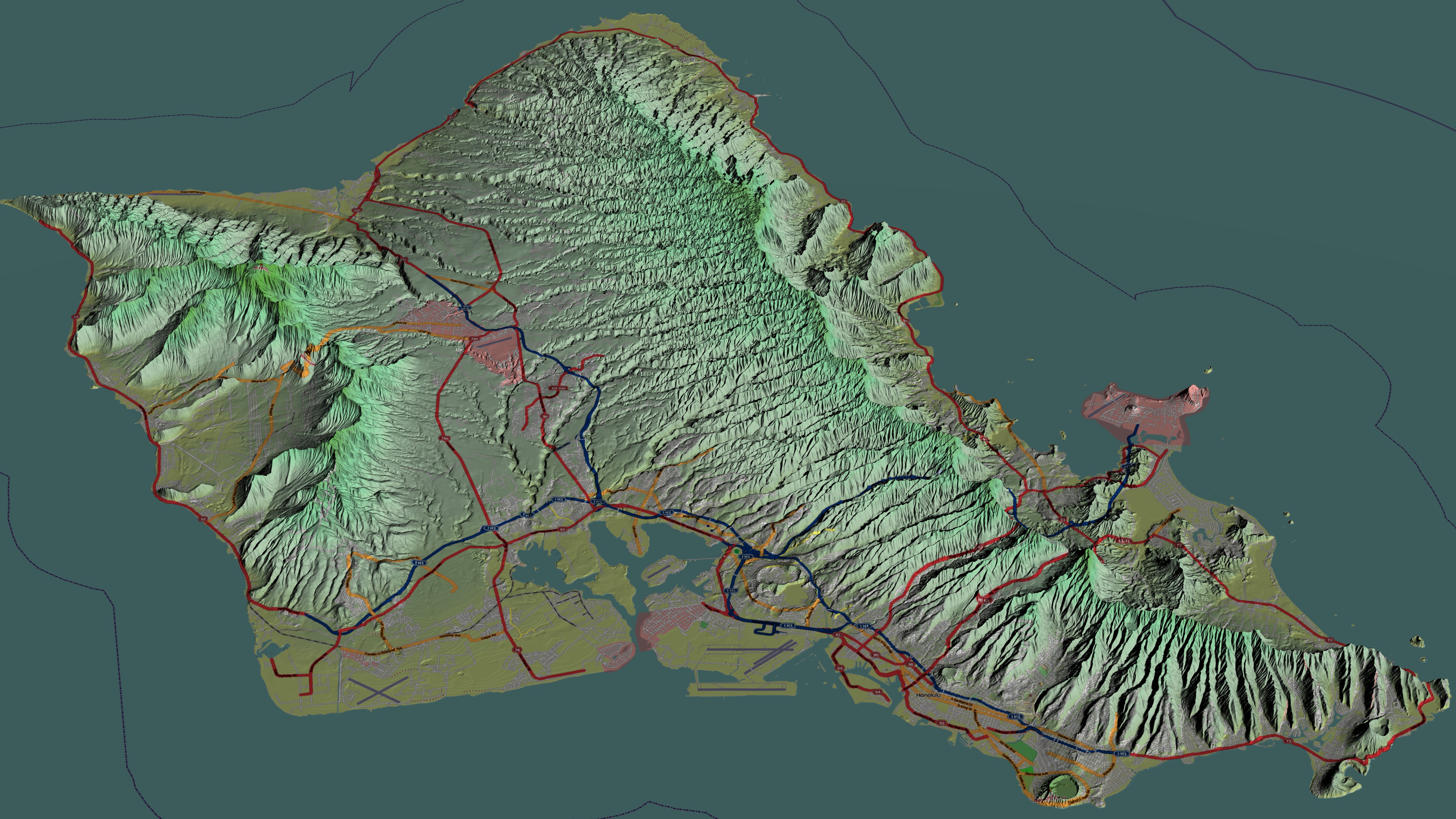|
Kaumualiʻi
Kaumualiʻi (c. 1778–May 26, 1824) was the last independent aliʻi nui (supreme ruler of the island) of Kauaʻi and Niʻihau before becoming a vassal of Kamehameha I within the unified Kingdom of Hawaiʻi in 1810. He was the 23rd high chief of Kauaʻi and reigned during 1794–1810. Although he was sometimes known as George Kaumualiʻi, he should not be confused with his son, who is more commonly known by that name. In Hanama'ulu, the King Kaumuali'i Elementary School is named after Kauai's last reigning chief. Family Kaumualiʻi was the only son of Queen Kamakahelei, aliʻi nui of Kauaʻi and Niʻihau, and her husband, Aliʻi Kāʻeokūlani (c. 1754–1794), regent of Maui and Molokaʻi. Kāʻeokūlani was the younger son of Kekaulike, the 23rd Aliʻi Aimoku and Moʻi of Maui. He became the co-king and effectively ruler of Kauaʻi by his marriage. When Kamakahelei died in 1794, she passed their titles and positions to the 16-year-old Kaumualiʻi, who reigned under the re ... [...More Info...] [...Related Items...] OR: [Wikipedia] [Google] [Baidu] |
Deborah Kapule
Deborah Kapule Kekaihaʻakūlou (c. 1798–1853) was the last Queen of Kauaʻi (as wife to Kaumualiʻi) before the establishment of the Kingdom of Hawaiʻi by King Kamehameha I. Life She was born around 1798; the location of her birth is not known for certain but, since she lived around Waimea and since she received property there from her father in later life, it is assumed that this was her birthplace. Her genealogy is not well documented. According to one source, her father was a High Chief Hāʻupu of Waimea, who was one of the chiefs whom King Kaumualiʻi sent to Oahu in 1810. But according to Hawaiian historian Samuel Kamakau, her (or at least Kekaihaʻakūlou's) parents were Kaiʻawa and Hāwea. Kaiʻawa was a counselor to Kaumualiʻi's father Kāʻeokūlani and was connected to Kāneikaheilani, a chiefess from Kaua'i who was the grandmother of Haʻalou, the maternal grandmother of Queen Kaʻahumanu, and also to Kaweloamaihunāliʻi, an early King of Kauaʻi. Hāwea w ... [...More Info...] [...Related Items...] OR: [Wikipedia] [Google] [Baidu] |
Hawaiian Kingdom
The Hawaiian Kingdom, or Kingdom of Hawaiʻi ( Hawaiian: ''Ko Hawaiʻi Pae ʻĀina''), was a sovereign state located in the Hawaiian Islands. The country was formed in 1795, when the warrior chief Kamehameha the Great, of the independent island of Hawaiʻi, conquered the independent islands of Oʻahu, Maui, Molokaʻi and Lānaʻi and unified them under one government. In 1810, the whole Hawaiian archipelago became unified when Kauaʻi and Niʻihau joined the Hawaiian Kingdom voluntarily. Two major dynastic families ruled the kingdom: the House of Kamehameha and the House of Kalākaua. The kingdom won recognition from the major European powers. The United States became its chief trading partner and watched over it to prevent other powers (such as Britain and Japan) from asserting hegemony. In 1887 King Kalākaua was forced to accept a new constitution in a coup by the Honolulu Rifles, an anti-monarchist militia. Queen Liliʻuokalani, who succeeded Kalākaua in ... [...More Info...] [...Related Items...] OR: [Wikipedia] [Google] [Baidu] |
Kinoiki Kekaulike
Kinoiki Kekaulike I was a Princess of the island of Kauaʻi during the transition from ancient Hawaii to the Kingdom of Hawaii. Biography She was born in the early 19th century. Her father was King Kaumualiʻi (1778–1824), descended from the royal family of Kauaʻi through his mother, Queen Kamakahelei and the royal family of Maui through his father Kaeokulani. Her mother was Kaʻapuwai Kapuaʻamohu, her father's stepdaughter and niece, daughter of Queen Kawalu, another wife of Kaumualiʻi being his half-sister, by her first husband, Chief Palikua of Koloa. Her mother was also granddaughter of Kamakahelei and Kaneoneo, the exiled king of Oʻahu who had been overthrown by the chiefs of Oʻahu and replaced by ʻEwa chief Kahahana. Her brother was Prince Kealiiahonui, a member of the 15 seat counsel of King Kamehameha III's House of Nobles and last prince of Kauaʻi. She married the Ali'i Nui of Hilo, Kūhiō Kalanianaʻole, son of Chief Elelule, by his wife, Chiefess Poʻom ... [...More Info...] [...Related Items...] OR: [Wikipedia] [Google] [Baidu] |
Kamehameha II
Kamehameha II (November 1797 – July 14, 1824) was the second king of the Kingdom of Hawaii. His birth name was Liholiho and full name was Kalaninui kua Liholiho i ke kapu ʻIolani. It was lengthened to Kalani Kaleiʻaimoku o Kaiwikapu o Laʻamea i Kauikawekiu Ahilapalapa Kealiʻi Kauinamoku o Kahekili Kalaninui i Mamao ʻIolani i Ka Liholiho when he took the throne. Early life Kamehameha II was born in the month of Hanaiaʻeleʻele (corresponding to November) 1797 in Hilo, on the island of Hawaiʻi, the first born son of Kamehameha I with his highest-ranking wife Keōpuolani. It was originally planned that he would be born at the Kūkaniloko birth site on the island of Oʻahu but the Queen's sickness prevented travel. Given in care to his father's trusted servant Hanapi, who took the child to rear him in the lands of Kalaoa in Hilo Paliku, he was taken back, after five or six months, by his maternal grandmother Kekuʻiapoiwa Liliha because she felt he was not getting th ... [...More Info...] [...Related Items...] OR: [Wikipedia] [Google] [Baidu] |
Russian Fort Elizabeth
Pā'ula'ula State Historical Park (Russian Fort Elizabeth) is a National Historic Landmark and is administered as the Pā'ula'ula State Historical Park just southeast of present-day Waimea on the island of Kauai in Hawaii. It is located at the site of the former Fort Elizavety (russian: Форт Елизаветы), the last remaining Russian fort on the Hawaiian islands, built in the early 19th century by the Russian-American Company as the result of an alliance with High Chief Kaumualii. The star fort was employed by the Kingdom of Hawaii in the 19th century under the name Fort Hipo ( haw, Paulaula o Hipo). History In 1815, German physician Georg Anton Schäffer, an agent of the Russian-American Company, arrived in Hawaii to retrieve goods seized by Kaumualii, chief of Kauai island.Khlebnikov, K.T., 1973, Baranov, Chief Manager of the Russian Colonies in America, Kingston: The Limestone Press, According to the company instructions, Schäffer had to begin by establish ... [...More Info...] [...Related Items...] OR: [Wikipedia] [Google] [Baidu] |
Humehume
Humehume (c. 1798–1826), known by many different names during his time, such as George Prince, George Prince Kaumualii, Tamoree or Kumoree by American writers, was a son of the king of part of the Hawaiian Islands. He traveled widely, served in the U.S. military, and led a failed rebellion on the island of Kauai. Early life He was born in the late 1790s with the name Humehume. His father was King Kaumualii, ruler of the islands of Kauai and Niihau. His mother was a commoner, of whom not much is known. This might explain an important event that happened when he was a young boy. In January 1804 the American trading ship ''Hazard'' arrived at Kauai. Since the landing of Captain James Cook in January 1778, the port of Waimea had been a known stop for European and American ships in the Pacific. King Kaumualii paid Captain James Rowan of the American trading ship ''Hazard'' to take his son aboard, ostensibly to get an education in America. A more believable theory is that Kaumualii ... [...More Info...] [...Related Items...] OR: [Wikipedia] [Google] [Baidu] |
Atahualpa (ship)
''Atahualpa'' was a United States merchant ship that sailed on four maritime fur trading ventures in the early 1800s. In 1813, in the Hawaiian Islands, ''Atahualpa'' was sold to the Russian-American Company (RAC) and renamed ''Bering'' or ''Behring''. In January 1815 ''Bering'', under the command of the American James Bennett, returned to Hawaii where it wrecked at Waimea Bay, Kauai. ''Atahualpa'' was a 210 ton ship built at Kennebunk, Maine. Its sister ship was ''Guatimozin''. The ''Atahualpa'' was named after the last Inca emperor Atahualpa. ''Guatimozin'' was named after the last Aztec emperor Guatimozin. Both ships were owned by the Boston company of Theodore Lyman and Associates. First voyage In the summer of 1800 ''Atahualpa'', under the command of Dixey Wildes, left Boston in company with the ''Guatimozin''. ''Atahualpa'' sailed to the Pacific Northwest via Cape Horn to trade with the indigenous peoples of the Pacific Northwest coast for sea otter furs, which commanded ... [...More Info...] [...Related Items...] OR: [Wikipedia] [Google] [Baidu] |
Kamehameha I
Kamehameha I (; Kalani Paiea Wohi o Kaleikini Kealiikui Kamehameha o Iolani i Kaiwikapu kaui Ka Liholiho Kūnuiākea; – May 8 or 14, 1819), also known as Kamehameha the Great, was the conqueror and first ruler of the Kingdom of Hawaii. The state of Hawaii gave a statue of him to the National Statuary Hall Collection in Washington, D.C. as one of two statues it is entitled to install there. Birth and childhood Paternity and family history Kamehameha (known as Paiea at birth), was born to Kekuʻiapoiwa II, the niece of Alapainui, the usurping ruler of Hawaii Island who had killed the two legitimate heirs of Keaweʻīkekahialiʻiokamoku during civil war. By most accounts he was born in Ainakea, Kohala, Hawaii. His father was Keōua Kalanikupuapa'ikalaninui; however, Native Hawaiian historian Samuel Kamakau says that Maui monarch Kahekili II had '' hānai'' adopted (traditional, informal adoption) Kamehameha at birth, as was the custom of the time. Kamakau believe ... [...More Info...] [...Related Items...] OR: [Wikipedia] [Google] [Baidu] |
Kauai
Kauai, () anglicized as Kauai ( ), is geologically the second-oldest of the main Hawaiian Islands (after Niʻihau). With an area of 562.3 square miles (1,456.4 km2), it is the fourth-largest of these islands and the List of islands of the United States by area, 21st largest island in the United States. Nicknamed the Garden Isle, Kauai lies 73 miles (117 km) across the Channels of the Hawaiian Islands#Kaʻieʻie Waho Channel, Kauai Channel, northwest of Oahu, Oahu. This island is the site of Waimea Canyon State Park and the Na Pali Coast State Park. The United States Census Bureau defines Kauai as census tracts 401 through 409 of Kauai County, Hawaii, Kauai County, Hawaii, which comprises all of the county except the islands of Kaʻula, Lehua and Niihau, Niihau. The 2020 United States Census, 2020 United States census population of the island was 73,298. The most populous town is Kapaa, Hawaii, Kapaa. Etymology and language Hawaiian narrative locates the name's origi ... [...More Info...] [...Related Items...] OR: [Wikipedia] [Google] [Baidu] |
Oahu
Oahu () ( Hawaiian: ''Oʻahu'' ()), also known as "The Gathering Place", is the third-largest of the Hawaiian Islands. It is home to roughly one million people—over two-thirds of the population of the U.S. state of Hawaii. The island of O’ahu and the Northwestern Hawaiian Islands constitute the City and County of Honolulu. The state capital, Honolulu, is on Oʻahu's southeast coast. Oʻahu had a population of 1,016,508 according to the 2020 U.S. Census, up from 953,207 people in 2010 (approximately 70% of the total 1,455,271 population of the State of Hawaii, with approximately 81% of those living in or near the Honolulu urban area). Name The Island of O{{okinaahu in Hawaii is often nicknamed (or translated as) ''"The Gathering Place"''. It appears that O{{okinaahu grew into this nickname; it is currently the most populated Hawaiian Island, however, in ancient times, O{{okinaahu was not populous and was outranked by the status of other islands. The translation of ''"ga ... [...More Info...] [...Related Items...] OR: [Wikipedia] [Google] [Baidu] |
Georg Anton Schäffer
Georg Anton Schäffer (rarely russified as ''Yegor Nikolayevich'' or ''Egor Antonovich'' ''Sheffer''; ''von Schaeffer'' in Portuguese sources; 27 January 1779 – 1836) was a German physician in the employ of the Russian-American Company who attempted to conquer Hawaii for the Company and, ultimately, the Russian Empire. The bloodless Schäffer affair (1815–1817) or the Hawaiian spectacular, as it was called by contemporary Russians, became a significant financial blunder for the Company. In the 1820s Schäffer became an agent of the Empire of Brazil and recruited thousands of German emigrants, the ancestors of many members of the present-day German Brazilian community, for resettlement in Brazil. Early life Georg Anton Schäffer was born at Münnerstadt, Bavaria on 27 January 1779, in the Franconia region,Gomes, p. 19 as son of a distillery owner. He studied medicine at Würzburg's Juliusspital College of Medicine.Croft, p. 53 He joined Imperial Russian service as a su ... [...More Info...] [...Related Items...] OR: [Wikipedia] [Google] [Baidu] |
Alexander Andreyevich Baranov
Alexander Andreyevich Baranov (russian: Алекса́ндр Андре́евич Бара́нов; 1747 – 1819), sometimes spelled Aleksandr or Alexandr and Baranof, was a Russian trader and merchant, who worked for some time in Siberia. He was recruited by the Shelikhov-Golikov Company for trading in Russian America, beginning in 1790 with a five-year contract as manager of the outpost. He continued to serve past the end date of his contract. In 1799 Baranov was promoted, appointed by the recently chartered Russian-American Company as Chief Manager, effectively the first governor of Russian America. He served until 1818. This was the early colonial period of expansion of settlements. He founded Pavlovskaya (Kodiak) and later New Archangel (Sitka), Russian colonies that were bases of the company in present-day Alaska. In addition, he oversaw the expansion of the lucrative fur trade with Alaska Natives. He continued to support his Russian wife and children, who had moved f ... [...More Info...] [...Related Items...] OR: [Wikipedia] [Google] [Baidu] |








